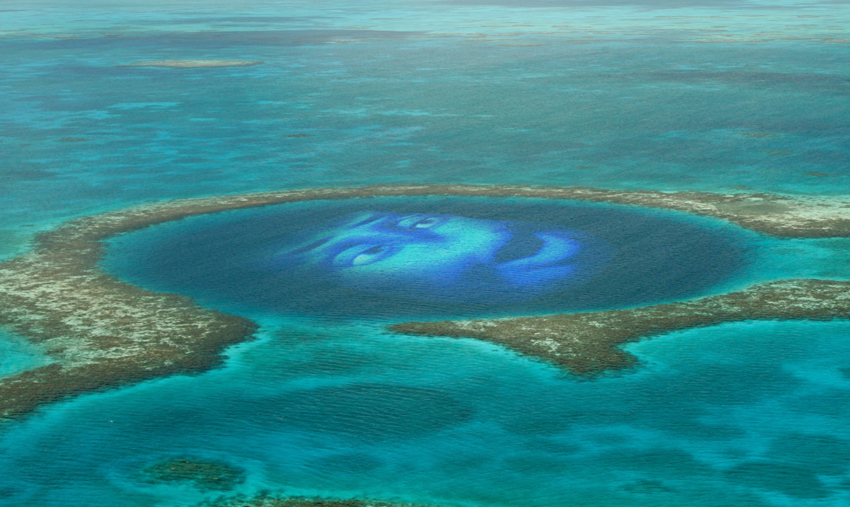The Hole 459 Yards
Deep, deep sinkhole one more reminder of ocean’s mysteries

Take a really big breath: The world has a new record-holder for the deepest blue hole, and it’s pretty darn deep.
Located in the Chetumal Bay of the Yucatán Peninsula, near the Mexico-Belize border, the aptly named Taam Ja—”deep water” in the Mayan language–was previously believed to be about 900 feet deep. That’s deep for sure, but it’s 87 feet shy of the South China Sea’s Dragon Hole. But the order got flipped when researchers measured it down to a depth of 1,380 feet, more than a quarter of a mile; they say it could be deeper still.
Wait, what’s a blue hole?
These massive underwater sinkholes look darker than surrounding waters thanks to their massive depth. Like most sinkholes, blue holes typically form in limestone and other carbonate rock formations, when erosion forms caves and then the cave roof collapses.
Many existing blue holes started out as dry caves during the last Ice Age 14,000 years ago, and filled with water as global sea levels rose. In some of these underwater caverns, stalactites, stalagmites, and even human burial grounds have been discovered.
How did they screw up the previous measurement so badly?
These scientists used a CTD profiler, named for its suite of measurements: water conductivity, temperature, and depth. Previously it had only been measured with sonar (it was just discovered in 2021; give ‘em some time!).
What can scientists learn from blue holes?
Lots of things! For one, scientists at the Great Blue Hole in Beliz may have discovered what killed off the Mayan civilization. Cores drilled at the site showed a decrease in the titanium content between 800 and 1,000 BCE. Since titanium from the area’s volcanic rock is redistributed by rainwater, this suggests a couple centuries of widespread drought and famine.
The holes also have a uniquely layered water column, with a low-oxygen layer on top of a gas-heavy layer that has no oxygen at all. These environments favor life forms big and small that have low oxygen needs (and low light needs, and high pressure tolerance), which can help researchers understand biological resilience generally.
The same conditions are also handy for preserving plant and animal fossils, so they’re full of valuable info for paleontologists.
Isn’t the Yucatán where that big asteroid hit and killed the dinosaurs?
Yes, but the Chixculub crater is on its northwest corner, and this is at the southeast. They do have an indirect connection though: the rim of the underground crater is marked by a ring of the inland sinkholes called cenotes. That’s because groundwater can’t flow through the rim itself, but instead takes specific paths around it, undermining the ground along those paths.
Some other blue holes around the world
Taam Ja now takes the title of the deepest blue hole in the world with a (non-final) measurement of 1,380 feet. It surpasses the Tiger Hole, and the aforementioned Great Blue Hole–which is “only” 407 feet deep, but named by none other than Jacques Cousteau as one of the world’s best diving sites.
A few others:
- Dean’s Blue Hole, Bahamas (663 feet): In 2023, a French free diver broke a record here, diving to 400 feet without an oxygen tank. (Note: He was crazy, and you shouldn’t try this. If you don’t believe us, check out the next hole.)
- Blue Hole of Dahab, Egypt (462 feet): Like many thrill-seekers’ paradises, it’s also a veritable graveyard, with a body count of up to 200.
- Gozo Blue Hole, Malta (82 feet): This one’s famous not for its depth or danger, but for its location: Next to Coral Cave and the former site of the Azure Window, a limestone arch that was featured on Game of Thrones before collapsing in 2017.
